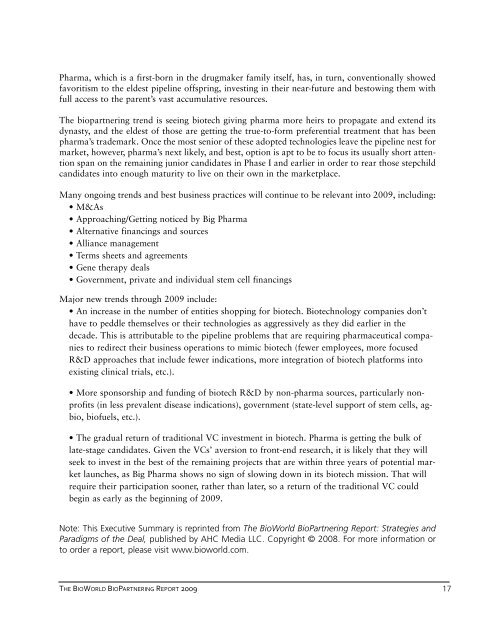BioPartnering Executive Summary - 3.qxd - Medical Device Daily
BioPartnering Executive Summary - 3.qxd - Medical Device Daily
BioPartnering Executive Summary - 3.qxd - Medical Device Daily
Create successful ePaper yourself
Turn your PDF publications into a flip-book with our unique Google optimized e-Paper software.
Pharma, which is a first-born in the drugmaker family itself, has, in turn, conventionally showed<br />
favoritism to the eldest pipeline offspring, investing in their near-future and bestowing them with<br />
full access to the parent’s vast accumulative resources.<br />
The biopartnering trend is seeing biotech giving pharma more heirs to propagate and extend its<br />
dynasty, and the eldest of those are getting the true-to-form preferential treatment that has been<br />
pharma’s trademark. Once the most senior of these adopted technologies leave the pipeline nest for<br />
market, however, pharma’s next likely, and best, option is apt to be to focus its usually short attention<br />
span on the remaining junior candidates in Phase I and earlier in order to rear those stepchild<br />
candidates into enough maturity to live on their own in the marketplace.<br />
Many ongoing trends and best business practices will continue to be relevant into 2009, including:<br />
• M&As<br />
• Approaching/Getting noticed by Big Pharma<br />
• Alternative financings and sources<br />
• Alliance management<br />
• Terms sheets and agreements<br />
• Gene therapy deals<br />
• Government, private and individual stem cell financings<br />
Major new trends through 2009 include:<br />
• An increase in the number of entities shopping for biotech. Biotechnology companies don’t<br />
have to peddle themselves or their technologies as aggressively as they did earlier in the<br />
decade. This is attributable to the pipeline problems that are requiring pharmaceutical companies<br />
to redirect their business operations to mimic biotech (fewer employees, more focused<br />
R&D approaches that include fewer indications, more integration of biotech platforms into<br />
existing clinical trials, etc.).<br />
• More sponsorship and funding of biotech R&D by non-pharma sources, particularly nonprofits<br />
(in less prevalent disease indications), government (state-level support of stem cells, agbio,<br />
biofuels, etc.).<br />
• The gradual return of traditional VC investment in biotech. Pharma is getting the bulk of<br />
late-stage candidates. Given the VCs’ aversion to front-end research, it is likely that they will<br />
seek to invest in the best of the remaining projects that are within three years of potential market<br />
launches, as Big Pharma shows no sign of slowing down in its biotech mission. That will<br />
require their participation sooner, rather than later, so a return of the traditional VC could<br />
begin as early as the beginning of 2009.<br />
Note: This <strong>Executive</strong> <strong>Summary</strong> is reprinted from The BioWorld <strong>BioPartnering</strong> Report: Strategies and<br />
Paradigms of the Deal, published by AHC Media LLC. Copyright © 2008. For more information or<br />
to order a report, please visit www.bioworld.com.<br />
THE BIOWORLD BIOPARTNERING REPORT 2009<br />
17

















